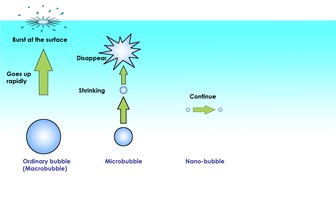NanoSight, manufacturers of unique nanoparticle characterization technology, are happy to report that Kaneo Chiba and Masayoshi Takahashi of Japan's famous AIST research centre are using nanoparticle tracking analysis (NTA) technology to characterize nanobubbles.

They have shown that in the presence of electrolytes and with the correct physical stimulus, stable nanobubbles can be formed from conventional microbubbles. The latter either tend to coalesce to larger buoyant bubbles which float away or collapse under intense surface tension-derived pressure to the point they vanish as predicted by theory. The addition of salt (electrolytes) however, is thought to cause the formation of a counter-ion screen around nanobubbles which effectively blocks the ability of gases within the nanobubbles to diffuse out. This was confirmed by electrophoresis studies in which the zeta potential of nanobubbles was shown to be related to nanobubbles stability.
There exists a wide range of proposed applications of nanobubbles and interest in their usage is growing rapidly. When formed from ozone and electrolyte stabilised, disinfection and sterilisation is possible for many months with great potential in the preservation of foodstuffs and in medical applications as an attractive alternative to chlorine based methodologies. Oxygen nanobubbles have been implicated in the prevention of arteriosclerosis by the inhibition of mRNA expression induced by cytokine stimulation in rat aorta cell lines.
When formed in liquids in capillaries, nanobubbles have been shown to greatly improve liquid flow characteristics. They have also been proposed as contrast agents in scanning techniques as well as cleaning agents in silicon manufacturing processes.
NanoSight's NTA approach has been shown to be ideally suited to such analyses and in a blind experiment in which three samples of nanobubbles suspensions containing high, low and zero numbers of nanobubbles were tested in duplicate, NanoSight results were found to match exactly those predicted. It is noted that NanoSight allows concentration of nanobubbles per unit volume to be estimated as well as size and size distribution.
Another user group in Japan, Ichiro Otsuka of Ohu University has studied the possible role of nanobubbles in ultra-high diluted samples of active agents in which the phenomenon of succussion is considered to relevant. He used NanoSight's technology to examine nanobubbles formation and concentration in more detail than was possible using an electrozone (Coulter) method or conventional dynamic light scattering (DLS) techniques.
To learn more about nanobubbles and their characterization using NTA, please visit www.nanosight.com and read an article from NanoSight's CTO, Bob Carr, in the latest issue of NanoTrail, the company's eNewsletter.